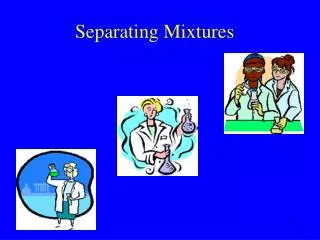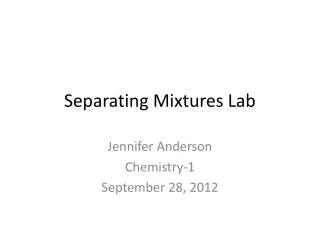
Separating Mixtures. What is a mixture?. When two or more materials or substances are mixed together but do not chemically combine. This means they retain their original properties. This means they can be separated by physical means. What are the different ways of separating mixtures?.

dorie + Follow
Download PresentationAn Image/Link below is provided (as is) to download presentation Download Policy: Content on the Website is provided to you AS IS for your information and personal use and may not be sold / licensed / shared on other websites without getting consent from its author. Content is provided to you AS IS for your information and personal use only. Download presentation by click this link. While downloading, if for some reason you are not able to download a presentation, the publisher may have deleted the file from their server. During download, if you can't get a presentation, the file might be deleted by the publisher.

Separating Mixtures. How do we separate …?. Filtration Chromatography Centrifuging Evaporating Crystallisation Dissolving Decantation Sieving Flotation Sedimentation.
1.11k views • 20 slides

SEPARATING MIXTURES. Chapter 3. SEPARATING MIXTURES. Because substances in a mixture are physically combined, the processes used to separate a mixture are based on difference in physical properties Sometimes it’s not easy to separate a mixture. FILTRATION.
472 views • 8 slides

Separating Mixtures. How do we separate …?. Filtration Chromatography Centrifuging Evaporating Dissolving.
499 views • 18 slides

Separating Mechanical Mixtures. Thursday April 3 rd , 2014 Period 3 - 707. Separating Mechanical Mixtures. Generally speaking, separating mechanical mixtures is easier, because the components of the mechanical mixture are usually quite different from each other. . Filtration.
637 views • 7 slides

Separating Mixtures. You can separate some mixtures using filtrations or a screen. You can separate mixtures by using a magnet . You can separate mixtures through evaporation.
540 views • 4 slides

SEPARATING MIXTURES. SEPARATING MIXTURES. Discuss with a partner how you would separate the following mixtures… Salt water Muddy water Iron filings and sand Vegetable oil and sand Vegetable oil and water Salt and pepper Be prepared to defend your answers!
447 views • 11 slides

Investigating Separating Mixtures. Lab. Task Card 1 (Sand/Salt). 2a) Sand – brown crystals Salt – White crystals Heterogeneous Mixture Gritty 2b) Salt dissolves in water (soluble). Sand does not dissolve in water 2e) Sand remains in the filter
192 views • 5 slides

Matter : Separating Mixtures. Separating Mixtures. Differences in physical properties can be used to separate mixtures. Some can be separated easily by physical means: rocks and marbles, iron filings and sulfur (use magnet) . Separating Mixtures. Heterogeneous Mixtures
926 views • 8 slides

Separating Mixtures. August 31. How do you separate?. How can you separate mixtures?. Separating. Separating is based on the difference in physical properties of the substances… Think about how you would separate a bag of m&ms Some mixtures are easier to separate than others.
396 views • 14 slides

Separating Mixtures. By Jason. Filtering and Sieving. Filtration only allows smaller particles than the designated area to flow through to the next layer causing oversized particles to stop and not make it through to the next layer.
275 views • 9 slides

Separating Mixtures. What is a mixture?. When two or more materials or substances are mixed together but do not chemically combine. This means they retain their original properties. This means they can be separated by physical means. What are the different ways of separating mixtures?.
3.73k views • 15 slides
 Separating Mixtures Lab" width="320px" />
Separating Mixtures Lab" width="320px" />
Separating Mixtures Lab. Jennifer Anderson Chemistry-1 September 28, 2012. Sieving. Procedure: . Evaporation. Procedure:. Gravity Filtration. Magnetic Attraction. TLC Chromatography. Decantation. Conclusion. Sieving— aalkdsjflakdsjf;alsdjfasf Evaporation– aldjf;aldskfja;dslf.
269 views • 8 slides

SEPARATING MIXTURES. What everyday items can you think of that need to be separated and what are the processes used to complete these separations?. SIEVING…. DECANTING…. water supply-upper layer taken for use after sedimentation. MAGNETIC SEPARATION…. SEPARATING ORES FROM MINED EARTH.
480 views • 15 slides

Separating Mixtures. Must be a difference in physical properties to separate a mixture. Filtration. Difference in particle size. Decanting. Liquid is poured off, while the solid remains. Distillation. Difference in boiling points
689 views • 7 slides

Separating Azeotropic Mixtures. CHEN 4460 – Process Synthesis, Simulation and Optimization Dr. Mario Richard Eden Department of Chemical Engineering Auburn University Lecture No. 6 – Review of Non-ideal Thermodynamics September 27, 2011
658 views • 21 slides

Separating Mixtures. http://www.youtube.com/watch?v=jWdu_RVy5_A. The components of a mixture can be separated based on the physical properties of: Magnetism Density
1.22k views • 5 slides

Separating Mixtures. Separating Mixtures. Filtration = The process that separates a solid from a liquid. Separating Mixtures. Distillation = The process where a liquid is boiled to produce a vapor that is then condensed in a liquid. Separating Mixtures.
804 views • 5 slides

Separating Mixtures. Purpose. To separate mixtures using a substance’s physical properties. Materials. Beaker, 50 mL Beaker , 250 mL Hot plate Filter paper Triple beam balance Magnet Salt Stirring Rod Zinc. Water Screen Beaker, 100 mL Watch glass Iron Paper
399 views • 13 slides

Separating Azeotropic Mixtures. CHEN 4460 – Process Synthesis, Simulation and Optimization Dr. Mario Richard Eden Department of Chemical Engineering Auburn University Lecture No. 7 – Sequencing Separation of Azeotropic Mixtures October 2, 2012
267 views • 9 slides

Separating Complex Mixtures. Chapter 4. Introduction. Many commonly encountered types of physical evidence consist of complex mixtures of substances Examples include: Drugs are often mixed with other substances (sugars) Gasoline contains over 300 different substances
306 views • 28 slides

Separating Mixtures. What is a mixture?. When two or more materials or substances are mixed together but do not chemically combine. This means they retain their original properties. This means they can be separated by physical means. What are the different ways of separating mixtures?.
230 views • 19 slides

Separating Mixtures. What is a mixture?. When two or more materials or substances are mixed together but do not chemically combine . This means they retain their original properties . This means they can be separated by physical means. What are the different ways of separating mixtures?.
213 views • 14 slides